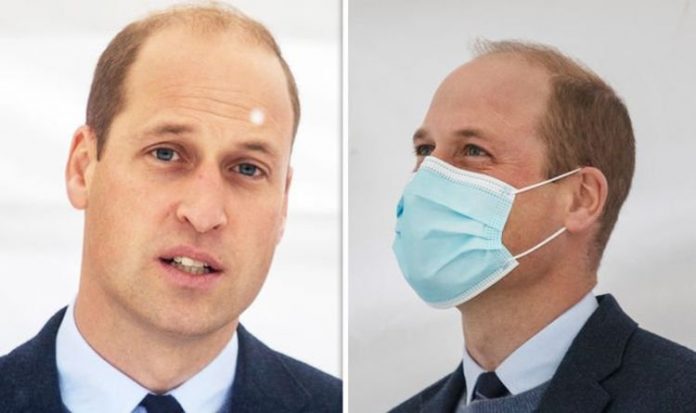William contracted COVID-19 in April. The Duke of Cambridge deliberately kept his diagnosis under wraps to avoid spreading mass panic, especially as his 71-year-old father Prince Charles had already gone public with his positive result just weeks before, according to reports. The second-in-line to the throne decided “there were important things going on and I didn’t want to worry anyone”.
Charles, the heir to the throne, spent seven days self-isolating in Scotland at the end of March after displaying mild symptoms.
While he recovered quickly, Prime Minister Boris Johnson tested positive at a similar time and was admitted to hospital in early April where he spent a few days in intensive care, leaving the nation on tenterhooks.
William was allegedly treated by Palace doctors and isolated at his family home Anmer Hall, in Norfolk, after he contracted the disease.
Kensington Palace has refused to comment officially on William’s diagnosis but he has since appeared in public several times, apparently fully recovered.

Prince William hid his positive coronavirus diagnosis from the public (Image: Getty)

William contracted coronavirus in April but his wife Kate Middleton tested negative (Image: Getty)
The BBC’s Jonny Dymond reported that the Palace always tries to assess the national mood while it also tries to “preserve some privacy” for the royals.
However, the news of William’s supposed diagnosis has upset some royal watchers.
Daily Express royal correspondent Richard Palmer tweeted: “If the future King contracts a potentially fatal virus that the entire world is worried about during a lockdown and he and those around him cover it up, that raises serious questions about whether we can trust anything he or his advisers say.”
Yet, the Royal Family has been keen to avoid upsetting the public in the past, as the monarchy provides a source of stability during trying times.
READ MORE: Prince William made ‘political statement under guise of mental health’

King George V died in January 1936 after his health started to naturally decline (Image: Getty)
For instance, King George V — the Queen’s grandfather — fell ill with septicaemia in 1928 and he struggled to regain his health in the following years.
In January 1936, he retired to his Sandringham House bedroom claiming he was struggling from a cold and later died in that same room.
His lead physician Lord Dawson of Penn released a statement shortly before he had officially died which explained the “King’s life is moving peacefully towards its close”, leading the public to think his death would have been triggered by natural causes.
The following day, the monarch’s favourite newspaper, The Times, was informed and its front page read declared the King had a “peaceful ending at midnight”.
DON’T MISS
Diana trauma led Harry and William to take drastically different paths [INSIGHT]
Royal runaway: Kate and William narrowly avoided drama on wedding day [EXPLAINED]
Prince William ‘optimistic and always believes change is possible’ [EXPOSED]

King George V with his wife Queen Mary of Teck (Image: Getty)

King George V with his eldest son and successor, Edward, later Edward VIII and then Duke of Windsor (Image: Getty)
However, Lord Dawson’s diaries, published 50 years after George V’s death in 1986, revealed that the true circumstances surrounding the monarch’s decline, and how it had been handled, were concealed from the public.
In his journal, Lord Dawson wrote that he wanted the monarch to have a painless death and to maintain royal dignity by making sure the announcement of his passing could be reported “in the morning papers rather than the less appropriate evening journals”.
The physician supported euthanasia, and he wrote in his diary that he had sped up the sovereign’s decline by injecting him with two lethal doses of morphine and cocaine after 11pm.
This act is believed to have accelerated George’s death.
Lord Dawson’s records suggest he was told by George’s wife Queen Mary and his heir, the Prince of Wales — later Edward VIII — that they did not want the King to suffer if it was apparent his illness was fatal.

The Royal Family tree — King George V was the current Queen’s grandfather (Image: Express.co.uk)
However, the New York Times noted in 1986: “There is no indication that the King himself had been consulted.”
The report continued: “It is not clear from the notes how explicit Lord Dawson was in the exchange he reported with the Queen and Prince about the method of ending the King’s life, or whether this conversation had been initiated by the family or the physician.”
Royal biographer Angela Levin explained in a Channel 5 documentary, ‘George V: The Tyrant King’: “There’s been this argument about whether it was murder or euthanasia.
“If you look at it objectively, it was a huge decision to make to kill a king without absolute authority, it’s a very dark but interesting mystery.”
Buckingham Palace declined to comment on the revelation from Lord Dawson’s diaries, but a spokesperson said: “It happened a long time ago and all those concerned are now dead.”







